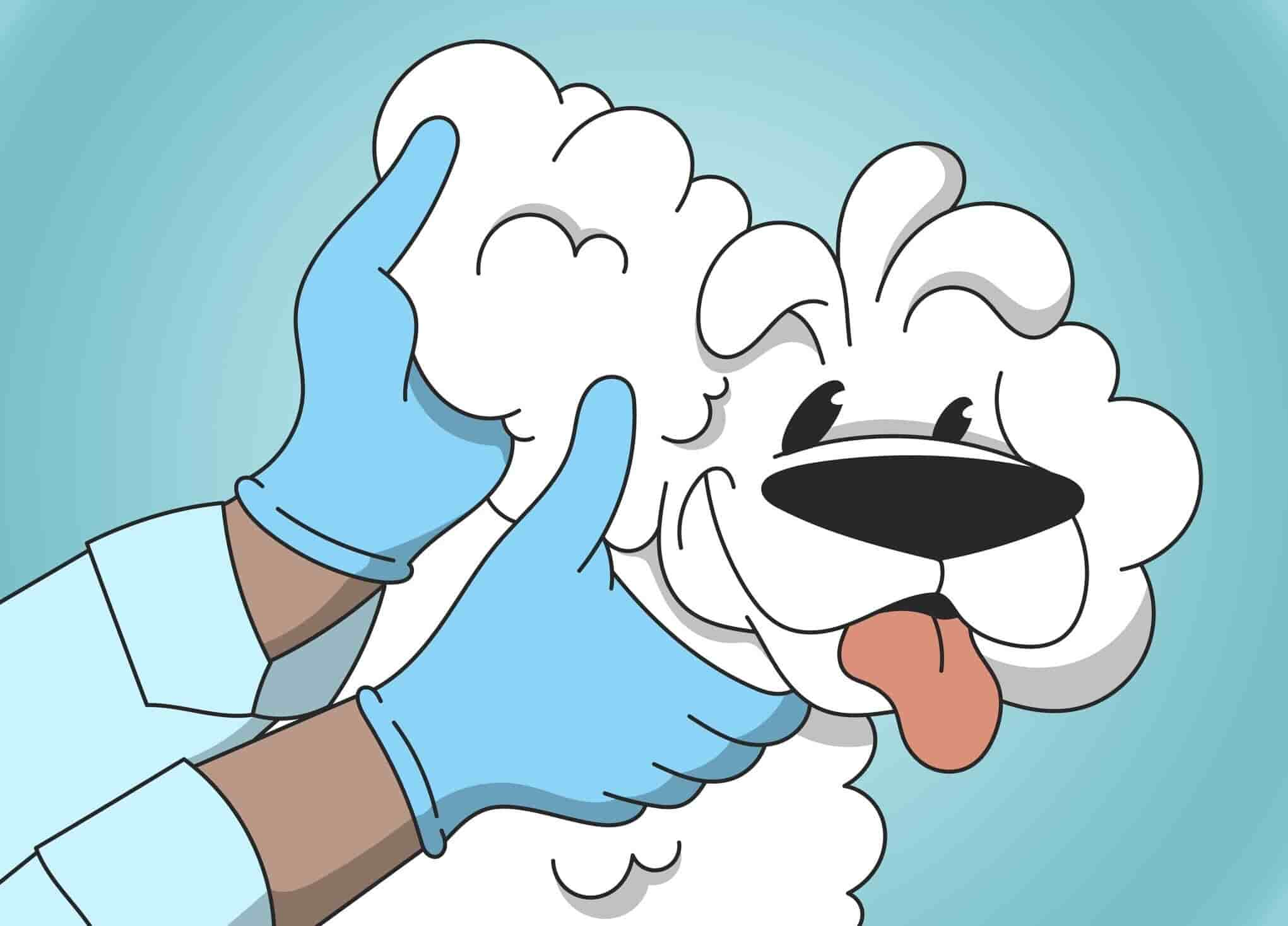When you sign up for pawrenthood, you sign up for a world of grooming that you might not have known exists. You'll need to brush your dog, wash them, shave or trim long hair, trim long nails, clean their teeth, and clean their ears.
That's right. You'll need to clean your dog's little ears. It's an essential part of dog grooming. If your dog regularly visits a professional groomer, the chances are that this task is being covered. It's a good idea to make sure, though.
According to research, neglecting ear cleanings can lead to a build-up of wax and oils, increasing the risk of ear infections and potentially even hearing damage.
This article was reviewed by our expert veterinarian, Chris Vanderhoof (DMV).
Signs your dog's ears need cleaning
How to tell if your dog's ears are due for a cleaning? Simple, lift those flappers up and have a look.
A healthy, clean ear is pink, odorless, and doesn't have grubby, waxy bits inside. If your dog's ears look like this, lay off the cleaning. When cleaning dogs' ears, there is such a thing as too much of a good thing.
Leave them alone if the ears look clean and don't smell funky. Overcleaning dogs' ears can be as harmful as not cleaning them.
However, if your doggo's ears look a little dirty or have a noticeable smell. It's time to get cleaning.
At this point, I'll mention some things to look out for. If your dog's ear looks inflamed or red or he seems to be in pain, it's best to contact your vet.
Your pup might have an ear infection, fleas, or another condition. Cleaning an infected ear can cause more harm than good.
Dog ear wax color chart
First, it's essential to know that not all discharge in your dog's ears is ear wax. Knowing what your doggo's normal is will help give you a solid baseline from which to work. Knowing what any changes to this could indicate will help you get your dog the treatment he needs as quickly as possible.
What do the different colors and smells of ear goo indicate?
Tan/yellow
- Details: Can sometimes appear slightly darker in color when mixed with dirt;
- Problem: This is common earwax;
- Treatment: A good ear cleaning should do the trick.
Dark brown
- Details: Accompanied by a strong smell, usually yeast-like;
- Problem: This may indicate a fungal infection;
- Cause: Fungal infections are common in dogs that swim a lot. This can be avoided by ensuring you dry your dog's ears thoroughly;
- Treatment: Clean your dog's ears twice a day until you no longer see any discharge and there's no smell.
Yellow to green with a strong smell
- Details: The strong smell will usually be your first clue that something's up;
- Problem: This indicates a bacterial ear infection;
- Cause: There can be several causes of bacterial ear infections, but underlying environmental or food allergies are among the most common;
- Treatment: Some bacterial ear infections will respond to treatment at home using over-the-counter medication. But, because bacterial growth can be relatively rapid, starting treatment as soon as you notice the problem is good. If you don't see an improvement in 72 hours, you should get to a vet for some stronger medication.
Black and granular
- Details: Can be described as looking like coffee grinds around your dog's ears;
- Problem: This is a sign of ear mites which can also lead to ear infections;
- Treatment: Your first job is to get rid of the ear mites. The sooner, the better. Using an ear mite medication and an ear flush, you'll need to clean your dog's ears twice a day until the mites are gone. If you suspect an ear infection is already present, it's a good idea to talk to a vet.
Dr. Vanderhoof notes that underlying environmental or food allergies can also be a common cause of yeast infections, especially when they recur.
Dog ear cleaning techniques
Not sure how to clean dog ears? If you're new to cleaning your dog's ears, here are some handy techniques to use:
- Make sure you gather all the tools and things you will use before you begin. Have everything within easy reach.
- If your dog has super hairy ears, you may need to trim some of the hair around the ear canal and ear flap.
- Get your dog to sit, reward him with a treat so he doesn't feel threatened, and let him have a good sniff of the bottle of ear cleaner.
- Make sure you have a good grip on your dog but not so restricting that they feel threatened. If you usually battle with bath time, expect ear cleaning to be much the same.
- Use your dog's ear flap as a funnel to guide the cleaning solution into the ear canal. Be careful not to insert the tip of the bottle directly into the ear.
- Use enough ear wash that the liquid starts to flow out from the ears.
- Massage the ear base for about 30 seconds to allow the wash to break up the wax and soften other debris in the ear.
- Use a soft cotton pad or gauze to wipe away any gunk from the inside of the ear flap and upper ear canal.
- Doggo is going to want to have a good head shake. Some would advise that you hold a towel over their head while they do this to prevent the solution from flying everywhere.
- Head shaking is essential to the process as it helps get any leftover ear wash and goop out of the inner canal where it's hard to reach.
- Wipe your dog's ears again using a cotton pad or gauze.
- Heap praise and treats and love upon your good boi.
Tips for cleaning your dog's ears
- Ear cleaning can be a messy business. Do it outside or in a confined area.
- Don't wear your best clothing for this.
- Get more ear wash than you think you'll need. You need to fill your dog's ear canal, and it's deeper than you think;
- If you've completed the process and your dog's ears still look dirty. Go ahead and repeat the process;
- If you see any redness or bleeding – stop.
Homemade solutions
A quick search on Google will yield an overwhelming number of homemade dog ear cleaner recipes. While there are some times when you can hack things at home to save some money, this is not one of them.
We recommend discussing this with your vet before trying any home remedies or DIY dog cleaner recipes. Ears are a fiddly business, and hearing is one of your dog's most important senses.
Medical/over-the-counter options
Most veterinary practices sell dog ear cleaner over the counter. If your dog has specific needs or you just want to be sure you're getting the right stuff, chat with your vet and ask for a recommendation.
Online Vet and Emergency Fund
Wouldn't it be great if you could send your vet a picture of your dog's ears and get advice without the drama and expense of a vet visit? The good news is that when you sign up with Petcube's Online Vet, you can access a team of trained veterinarians around the clock.
Simply sign up for just $20 a month, and you'll be able to message the team with images and video and have all your pet parenting questions answered.
What's more, is that for just $9 more a month, you can add on an emergency fund that will pay out up to $3000 a year for emergency care for your best pet pal.
Read more: What To Expect From An Online Vet Visit
FAQ
Are certain dog breeds prone to excess earwax?
Yes! Usually, dogs with long ears tend to experience more wax problems; cocker spaniels and bassets, for example. Also, dogs with hairy ears (like poodles) and those with excess skin folds (English bulldogs) can experience issues.
Excess ear wax can lead to ear infections, so it's crucial to be proactive.
What are the signs of a dog ear infection?
Look for the following:
- More frequent head shaking;
- Smelly ears;
- Red skin;
- Ear scratching;
- Discharge;
- Inflammation.
What does dog ear wax look like?
Dog ear wax is very similar to human ear wax. It's usually yellow to brown in color and sticky. Various other ear discharges can indicate the presence of fungal or bacterial infections and mites.
Can you put Peroxide in a dog's ears?
No. Peroxide is very strong and can actually damage healthy skin cells. Your dog's ears are very sensitive. It's best not to put anything in them without the guidance of a vet.
How to clean a dog's ears with vinegar?
Apple cider vinegar is one of the more commonly used home remedies for cleaning a dog's ears. There are risks to using this that you must be aware of. For example, if there are open sores or raw skin, vinegar will burn and cause more irritation.
Some conditions can be made much worse by using vinegar to clean your dog's ears. But it can also help dry out ears to combat fungal and bacterial infections.
It's essential to check with your vet first before using vinegar, as you may exacerbate the problem.
How often should I clean my dog's ears?
There's no one answer here. It will depend on your dog's unique needs. Some dogs require ear cleaning more frequently, while others, particularly those with short little ears, can get away with a quick wipe every now and then. Besides, you can always ask the vet online about it!

Was this article helpful?
Help us make our articles even better









